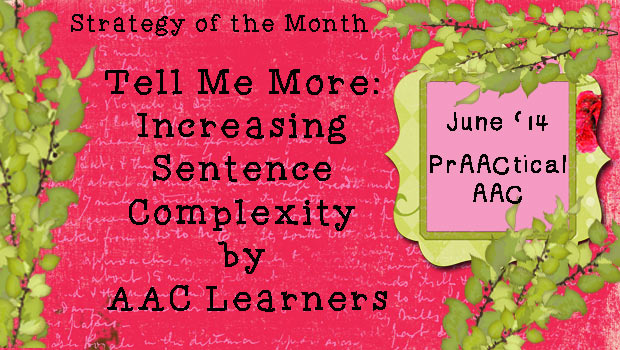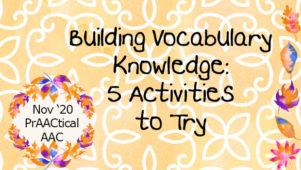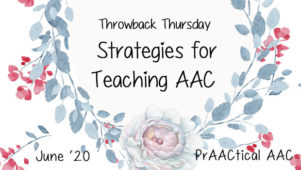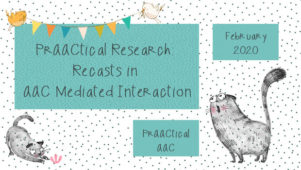Tell Me More: Increasing Sentence Complexity by AAC Learners

Expanding the length and complexity of sentences is something that SLPs love to work on well beyond the ‘early communicator’ phase, something we talked about a few weeks back. In today’s post, we’ll consider ways to build more complex utterances for learners who are gaining competence with their AAC systems but who still use language that is immature, imprecise, or overly simplistic. In many ways, this therapy is like language therapy for any other learner with delays in grammar, syntax, and morphology. Indeed, we sometimes forget to activate all that we know about language intervention when working learners who use AAC. We try to use that as a starting point and adjust for the AAC components as needed.
Here are some of the things that we think about when planning therapy for AAC learners who are trying to strengthen their ability to speak in more complex sentences.
Relate the language goal to their personal goals: Why work hard at something you don’t care about? Like the rest of us, AAC learners are the most motivated when the task leads to something we care about. We are most successful when we find a way to link what WE want as SLPs, to what THEY (and their families) want for their own lives.
Teach conversation starters: Many AAC learners struggle with getting started in conversation. Whether it is speaking up in the classroom, hanging out with friends, or chatting with family members, they often need help knowing what to say and practicing how to say it. Consider pre-programming messages like these:
- Can I tell you about something?
- Something funny/strange/important/weird happened.
- I forgot to tell you this.
- When you have time, I have something to tell you.
Better yet, brainstorm some conversation starters with your AAC client. Once the conversation is up and running, we have a perfect venue for increasing sentence complexity.
Consider working on conjunctions: Teaching conjunctions is a very effective way to lengthen sentences and make them more complex. I know that most of us learned FANBOYS, but we generally start with these conjunctions: and, because, but, or, before, after, if, so. Although not necessarily in that order [pun intended].
Don’t over-interpret: One of the reasons that many AAC learners habitually use simple language, is that their partners accept it. We use the context and our knowledge of the learner to read into their utterance and interpret what they are saying. Often (but not always), we guess correctly. That’s necessary in some contexts, of course. But think about this: When we do that, they have no need to be clearer, more detailed, or more precise in what they say. This is a big obstacle in therapy designed to make their language more sophisticated. When we do this, we ‘teach’ them to be dependent on informed, familiar listeners. Can anyone say ‘learned helplessness?’ Who me? Yes! That’s what we’re doing when we pull in all of that other knowledge to make guesses about what the AAC leaner ‘really’ meant. So, what’s a poor clinician to do? Instead of ‘reading into’ what our clients are saying, we can encourage them to use more advanced language by NOT over-interpreting their message. Put the ball back in their court by telling them when you don’t have enough information to understand. “So, I know that you’re telling me about the mall this weekend, but I’m not sure who you were with or what really happened.”
Use the ‘Perfect Pause:’ And then we wait. We look interested (we ARE interested!), and wait expectantly. 5 seconds, 10 seconds, 15 seconds, or more. It depends on what your AAC learner needs, but the idea is that we are creating a space for them to realize that they need to say more.
Use cloze sentences: Repeat what you know and pause to encourage the AAC learner to complete the sentence. “I am not happy.” “Oh, I’m sorry to hear that. I’m not happy because…”
Building longer, more sophisticated utterances is a process that takes time but is an investment worth making. Are you working on goals like this with your AAC learners? We’d love to hear the strategies and approaches that are working for you.
Filed under: Strategy of the Month
Tagged With: intervention, language intervention, sentence length, strategy
This post was written by Carole Zangari





2 Comments
You are great!!!
From my experience following Realize Language logs I would expect conjunctions to first appear at the beginning of conversational turns rather than in the middle.
“go to sleep!”
“but I am not tired”
I also see this as often more interesting than simple sentence length, because the aac user is putting their own utterance into the context of the partners conversation.